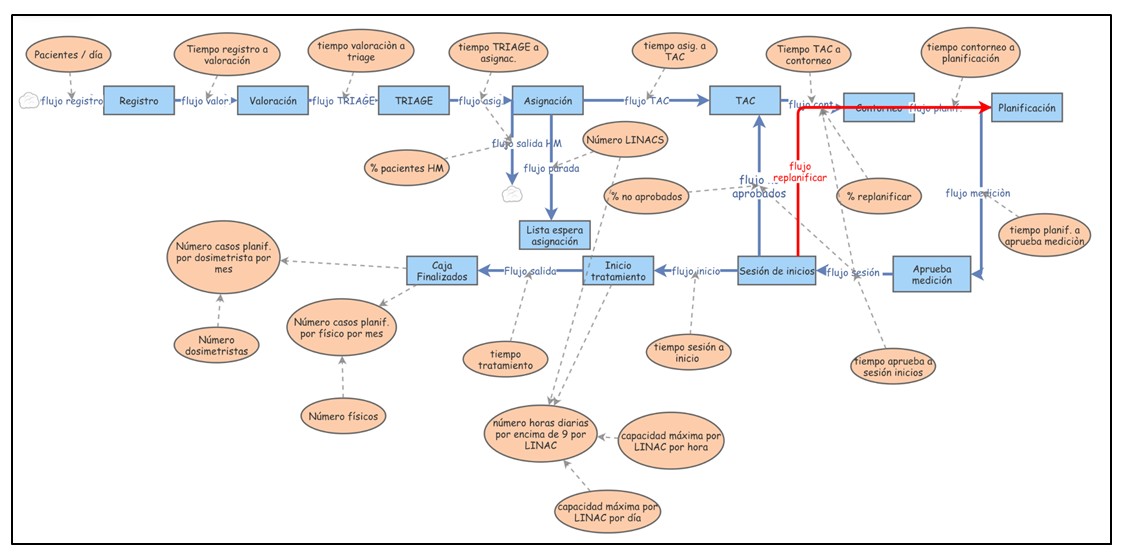This paper demonstrates how System Dynamics modeling can enhance operational efficiency in a high-demand healthcare environment, offering a strategic tool for decision-making in radiotherapy services. The HSJD model provides valuable insights into resource constraints and optimization opportunities, supporting sustainable healthcare improvements in Costa Rica.
1.Introduction
Cancer is one of the leading causes of mortality worldwide, affecting millions of people each year and exerting significant pressure on healthcare systems. In Costa Rica, in 2022 alone, 13,325 new cancer cases were reported, resulting in approximately 6,072 deaths. The three most prevalent types of cancer in the country are prostate, breast, and stomach cancer, accounting for 32% of new cases. [1]
The standard treatments for cancer globally include chemotherapy, surgery, and radiotherapy, with radiotherapy being an essential component for approximately 50% of cancer patients. Costa Rica follows this trend, offering radiotherapy services in two specialized centers located in the capital, San José. However, patients from rural and remote areas face significant logistical challenges in accessing these centers. Moreover, the high demand for treatment has resulted in resource constraints and patient referrals to other facilities due to capacity limitations.
To address these challenges, this paper proposes a System Dynamics model aimed at optimizing patient flow and resource allocation in the radiotherapy department of San Juan de Dios Hospital (HSJD). The model enables administrators to analyze bottlenecks, resource utilization, and operational constraints, facilitating data-driven decision-making to improve service efficiency.
2. Materials and Methods
2.1 Radiotherapy Department at HSJD
The HSJD radiotherapy center began operations in late 2022 and currently treats approximately 700 new patients per year, with around 572 completing their treatments. However, due to capacity limitations, 35% of patients were referred to other institutions in 2023. Estimates indicate that the hospital should be capable of treating 1,000 new patients annually, but this is hindered by a lack of linear accelerators (LINACs) and staff limitations.

Figure 1: Initial Model Representation
The patient workflow in the department (showed in Figure 1) follows a structured process that includes:
1. Registration and Evaluation – Patients undergo initial screening to determine eligibility for radiotherapy.
2. Treatment Planning – Eligible patients receive computed tomography (CT) scans for treatment planning.
3. Dosimetry and Quality Control – A radiation dose plan is developed and verified.
4. Treatment Delivery – Patients receive radiotherapy sessions administered by LINAC machines under medical supervision.
Each stage in this process is time-dependent, creating potential delays and inefficiencies. Additionally, machine failures and staff shortages further complicate the workflow, making mathematical modeling an ideal approach to analyze system performance.
2.2 System Dynamics Model
System Dynamics is a powerful methodology for understanding time-dependent behaviors in complex systems. The proposed model, developed using Insight Maker, represents the patient flow and resource allocation in the radiotherapy department. It includes:
- Stocks: Representing patient accumulation at different stages of treatment.
- Flows: Governing patient movement between stages.
- Variables: Including resource constraints (e.g., LINAC availability, staff capacity).
- Feedback Loops: Capturing dependencies between workload, treatment delays, and system performance.
Every patient follows a structured sequence of stations, beginning with registration, evaluation, and treatment assignment. Only eligible patients proceed to computed tomography (CT) scanning, which is essential for designing a personalized radiotherapy plan. The treatment plan, developed by physicians, dosimetrists, and physicists, ensures accurate radiation delivery via LINAC machines.
The patient flow is governed by time constraints and procedural dependencies. For example, a patient must complete registration and medical evaluation before undergoing a CT scan. After scanning, a computer-generated treatment plan is created to optimize radiation targeting while protecting healthy tissues. Before treatment begins, quality control tests are conducted using phantoms (simulated patients) to verify that LINAC machines deliver the correct radiation dose. These procedures follow international standards to ensure treatment accuracy and patient safety.
Since patient flow is highly time-dependent, System Dynamics modeling is an effective tool for understanding and optimizing operations. One critical factor is LINAC availability, as mechanical failures can suddenly reduce treatment capacity. If a LINAC fails, patient scheduling must be adjusted accordingly. A mathematical model allows administrators to simulate "what-if" scenarios, helping to assess the impact of different constraints on patient throughput.
To develop the model, detailed data collection was necessary. The study gathered information on processing times at each station, the number of patients referred elsewhere, and cases where treatment delays occurred due to resimulation needs. The research team worked closely with radiotherapy staff, validating the collected data against existing hospital records to ensure accuracy and consistency.
Once validated, the System Dynamics model was built using Insight Maker. The following figure illustrates the initial formulation of the model.

Figure 2: System Dynamics model built in Insight Maker
3. Results and Discussion
3.1 Model Validation
The model was validated by comparing simulated patient flow with real-world hospital data from 2023. The baseline simulation predicted that 634 patients would complete treatment annually, closely matching the 572 real cases reported in hospital records.
3.2 Scenario Analysis and Sensitivity Testing
To explore the impact of key constraints, we conducted scenario-based sensitivity analysis, testing:
1. LINAC Failures – Simulating machine downtime and its effect on patient backlog.
2. Staff Availability – Evaluating the impact of reduced personnel (due to absences or retirements).
3. Capacity Expansion – Testing scenarios with an additional LINAC machine and increased treatment slots.
3.2.1 Key Findings:
- Machine failures significantly increase patient backlog, reinforcing the need for preventive maintenance strategies.
- Staff shortages lead to increased waiting times, highlighting the importance of flexible workforce planning.
- Adding one more LINAC machine could increase treatment capacity to approximately 900 patients per year, reducing referrals by 50%.
3.3 Optimization Strategies
To enhance operational efficiency, we propose:
1. Resource Optimization – Adjusting appointment scheduling to minimize idle time.
2. Redundancy Planning – Ensuring backup plans for machine failures and staff shortages.
3. Process Streamlining – Reducing administrative bottlenecks in patient registration and treatment planning.
These strategies could improve service reliability and patient outcomes, making the radiotherapy department more resilient to external disruptions.
4. Conclusion
1. A System Dynamics model was developed to analyze and optimize the patient flow in HSJD’s radiotherapy department.
2. The model closely reflects real-world hospital operations, allowing administrators to test different scenarios.
3. Sensitivity analysis revealed the critical role of LINAC availability and staff capacity in system performance.
4. Adding one more LINAC machine could significantly reduce patient referrals, enhancing treatment accessibility.
5. The model serves as a decision-support tool, enabling data-driven resource allocation for improved patient care.
5. Future Work
Future improvements to the model could include:
- Integration of patient demographics to analyze the impact of age and tumor type on treatment schedules.
- Long-term capacity planning to anticipate growing cancer incidence rates in Costa Rica.
- Cost-benefit analysis of different investment scenarios (e.g., purchasing new LINACs vs. expanding staff).
6. References
1. International Agency for Research on Cancer. (2021). Costa Rica fact sheet. GLOBOCAN 2020. Retrieved from https://gco.iarc.who.int/media/globocan/factsheets/populations/188-costa-rica-fact-sheet.pdf
2. Alfeld LE, Graham AK (1976) Introduction to urban dynamics. Pegasus Communications, Waltham.
3. Richardson GP, Pugh Al III (1981) Introduction to system dynamics modeling with DYNAMO. MIT Press, Cambridge.
4. Sterman JD (2001) Business dynamics: system thinking and modeling for a complex world. Irwin McGraw-Hill, Boston.
5. Dangerfield, B. (Ed). (2020). System Dynamics: Theory and Applications. Springer.
6. Fortmann-Roe, S. (2014). Insight Maker: A general-purpose tool for web-based modeling and simulation. Simulation Modelling Practice and Theory, 47, 28-45.
(*) Puede solicitar información más detallada de este trabajo a los autores





